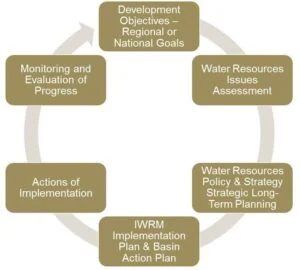
Why in news?
- In recent news, the discourse surrounding integrated river basin management has gained significant prominence, particularly concerning the Indus, Ganga, and Brahmaputra rivers – the lifelines of millions of people across South Asia.
- These rivers, with their vast basin areas spanning multiple countries, play a crucial role in sustaining livelihoods, supporting agriculture, and driving economic activities in the region.
- A recent report, jointly authored by the International Centre for Integrated Mountain Development (ICIMOD) and the Australian Water Partnership, has brought renewed attention to the urgent need for multilateral treaties to effectively address the multifaceted challenges facing these vital river systems.
- This collaborative effort underscores the recognition of the interconnectedness of these rivers and the necessity for coordinated action among riparian nations to ensure their sustainable management and preservation for future generations.
Integrated River Basin Management:
- Emphasizing collaboration among stakeholders and robust data sharing on aspects such as water availability, biodiversity, and pollution.
- Ensures holistic and sustainable management practices to cater to the diverse needs of human communities and ecosystems.
Importance of Multilateral Treaties:
- Despite existing bilateral agreements, the absence of multilateral treaties hinders effective governance of the Indus, Ganga, and Brahmaputra rivers.
- Urgent need for establishing treaties to facilitate coordinated and equitable management strategies transcending national boundaries.
Critical Dependence on River Basins:
- Millions of people in India, Tibet (China), Pakistan, Afghanistan, Nepal, and Bhutan heavily rely on resources from these river basins.
- Implementing comprehensive management strategies to address socio-economic and environmental challenges faced by the region.
Key Facts About the Ganga, Indus, and Brahmaputra River Basins:
- Ganga River Basin:
- Originates from the Gangotri Glacier in Uttarakhand, supporting millions across Indian states and Bangladesh.
- Numerous tributaries like the Yamuna, Ghagra, and Kosi rivers play crucial roles in agriculture and transportation.
- Indus River Basin:
- Emerging from Tibet, it serves as a lifeline for millions in India, Pakistan, and Tibet.
- Governed by the Indus Waters Treaty, necessitating collaborative efforts for equitable water-sharing and sustainable resource management.
- Brahmaputra River Basin:
- Originating from Tibet, it traverses through India, Bhutan, and Bangladesh, supporting diverse ecosystems.
- Network of tributaries vital for agriculture, hydropower generation, and inland navigation, requiring integrated management approaches.
Conclusion:
- The report underscores the urgency for collaborative action to address challenges confronting the Indus, Ganga, and Brahmaputra river basins.
- Prioritizing collaboration, data transparency, and the establishment of multilateral treaties are essential steps towards sustainable management practices that safeguard livelihoods and ecological integrity.
People also ask
1. What is integrated river basin management?
Ans: Integrated river basin management refers to a holistic approach to managing river systems, considering the interconnectedness of social, economic, and environmental factors within a basin. It involves collaboration among stakeholders and comprehensive planning to ensure sustainable use of water resources while addressing competing needs and challenges.
2. Why is integrated river basin management important?
Ans: Integrated river basin management is crucial for ensuring the sustainable development and preservation of river ecosystems. By considering the entire river basin as a unit of management, this approach helps balance competing interests, mitigate conflicts, and address issues such as water scarcity, pollution, and ecosystem degradation.
3. What are the key components of integrated river basin management?
Ans: Key components include collaborative governance structures involving all stakeholders, robust data collection and sharing mechanisms, strategic planning for water allocation and resource management, implementation of ecosystem-based approaches, and monitoring and evaluation to assess effectiveness and adapt strategies as needed.
4. How do multilateral treaties contribute to integrated river basin management?
Ans: Multilateral treaties provide a framework for cooperation among riparian countries sharing transboundary rivers. They facilitate dialogue, negotiation, and the establishment of shared objectives and mechanisms for managing water resources sustainably. By fostering collaboration and trust, multilateral treaties contribute to effective integrated river basin management.
5. What are some challenges associated with integrated river basin management?
Ans: Challenges include conflicting interests among stakeholders, inadequate institutional capacity and resources, data gaps and uncertainties, lack of political will and commitment to cooperation, and the complexities of managing transboundary river basins. Addressing these challenges requires sustained efforts, effective governance structures, and stakeholder engagement.
I don’t think the title of your article matches the content lol. Just kidding, mainly because I had some doubts after reading the article.